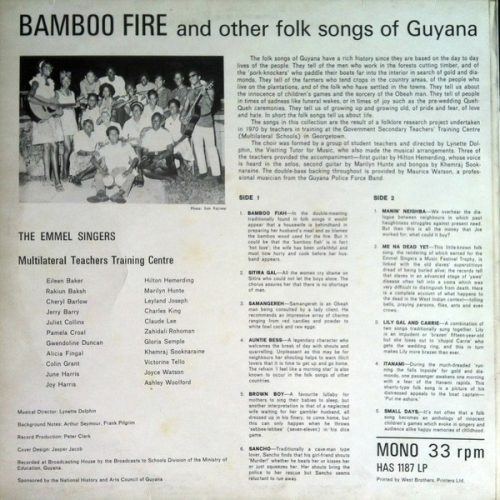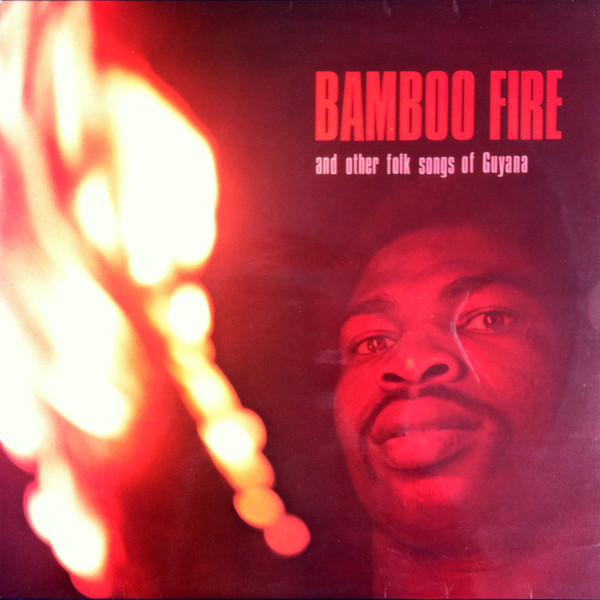
The nation takes particular pride in its vast and deep treasury of folk songs which are kept alive continuously through various stage performances, persistent playing on the radio stations, and most importantly, in the memory of its people. The popularity of these songs help and several of them are favourites that make an impact on national consciousness.

That is why there have been so many attempts, so many projects, so many strategies, including efforts at the level of national officialdom, to preserve this music. Folk songs entertain, but because they are engrained in cultural tradition and have evolved along with human society and social organisation, they tend to play significant roles in communities. They are means of social control, guardians of morality, sources of wisdom, expressions of culture, and narratives of human custom and behaviour.
Guyana can remember landmarks over many decades in attempts to protect, preserve and promote folk music. Not all of them were official. Prominent in the impact they have made are the performances of the Police Male Voice Choir, outstanding in what they have contributed to Guyanese folk music. More recently were the efforts of the folk singing group Korokwa, founded and directed by Deryck Bernard. This group was formed out of the Woodside Choir with a particular dedication to folk songs. Its name, Korokwa, was taken from an Amerindian word meaning “remembering”, which reflects the aim to preserve the folk songs in memory. Korokwa recorded a collection of the songs at the Kross Kolor studios, and for several years was the leading performing group in this genre.
Also of the greatest importance was the publication by the Department of Culture of Lynette Dolphin’s compilation, 100 Folk Songs of Guyana in 1996. This was a priceless landmark because it recorded these songs in print, commending them to posterity in effective fashion. The book was regarded as an invaluable national publication and was reprinted by the Caribbean Press in the Guyana Classics Series.
However, one of the most exceptional events in the history of these determined efforts at documentation was the recording of the LP ‘Bamboo Fire and Other Guyanese Folk Songs’ by the Emmel Singers. A former Director of Culture focused on that development in the following words: “In 1970 the Ministry of Education surprised itself when it caused to be produced a local LP of folk songs. Fifty years later we continue to be very proud of that musical tribute” and proposed “a tracer study of the group of singers of that LP titled the Emmel Singers.” At that time, to make such a recording was an achievement, and an ambitious and innovative project. Given the time and the local conditions, actually pulling it off was an extraordinary feat, a ground-breaking event and indeed, a source of great pride. The singers involved were all trainee teachers at the government’s Multilateral Teachers Training Centre in Georgetown. A group of 22 of them made the recording. At least two were already accomplished musicians – Hilton Hemerding the lead singer, well known for his popular composition “Beautiful Guyana”, and Marilyn Hunte (now Dewar), a prominent music educator and a foremost member of the Woodside Choir and Korokwa.
‘Bamboo Fire and Other Folk Songs of Guyana’ is a product of the technology of the time, a Mono 33 rpm record with 11 songs. The Musical Director was Lynette Dolphin with Record Production by Peter Clark. The LP was recorded at Broadcasting House by the Broadcast to Schools Division of the Ministry of Education and sponsored by the History and Arts Council of Guyana. At that time there was a significant rise in literature driven by the strong, dominant sense of nationalism which had been further propelled by political independence in 1966 and Republicanism in 1970. The History and Arts Council had been active, as was the Department of Culture that took over its functions years later.
The Emmel Singers were: Eileen Baker, Rakiun Baksh, Cheryl Barlowe, Jerry Barry, Juliet Collins, Pamela Croal, Gwendoline Duncan, Alicia Fingal, Colin Grant, June Harris, Joy Harris, Hilton Hemerding, Marilyn Hunte, Leyland Joseph, Charles King, Claude Lee, Zahidali Rohoman, Gloria Semple, Khemraj Sooknaraine, Victorine Tello, Joyce Watson, and Ashley Woolford.
The best narrative of how it started and who were involved comes from those who were there at the time. Famous Guyanese writers Arthur Seymour and Frank Pilgrim wrote the background notes for the album.
“The student teachers were directed by Lynette Dolphin, the Visiting Tutor for Music, who also did the musical arrangements. Hemerding was soloist and First Guitar, with Second Guitar by Hunte [Marilyn Dewar], bongos by Khemraj Sooknaraine and double bass by Maurice Watson, a professional musician from the Police Force Band. Cover Design was by Jasper Jacobs.
“The folk songs of Guyana have a rich history since they are based on the day-to-day lives of the people. They tell of the men who work in the forests cutting timber, and of the ‘pork-knockers’ who paddle their boats far into the interior in search of gold and diamonds. They tell of the farmers who tend crops in the country areas, of the people who live on the plantations, and of the folk who have settled in the towns. They tell us about the innocence of children’s games and the sorcery of the Obeah man. They tell of people in times of sadness like funeral wakes, or in times of joy such as the pre-wedding Queh-Queh ceremonies. They tell us of growing up and growing old, of pride and fear, of love and hate. In short the folk songs tell us about life.
“The songs in this collection are the result of a folklore research project undertaken in 1970 by teachers in training at the Government Secondary Teachers’ Training Centre (Multilateral Schools) in Georgetown.”
Dewar was able to give an up-to-date account of where the members of the Emmel Singers can be found today. According to her, most of them are now living overseas, the majority in the USA: Baker, Barry, Croal, Duncan, Grant, Joy Harris, Hemerding, Joseph, Semple, Sooknaraine and Watson. She still lives in Guyana, along with June Harris, Dewar, Lee and Tello. The whereabouts of Baksh, Collins, and Rohoman are not known, while Barlowe, King and Woolford are deceased.
It is also interesting to read the notes on the folk songs performed for the recording. The selections are: “Bamboo Fire”, “Sitira Gyal”, “Samangereh”, “Auntie Bess”, “Maanin Neighba”, “Me Na Dead Yet”, “Lily Gal and Carrie”, “Itanami”, “Small Days”. Some of these are among the most popular, and Seymour and Pilgrim offer interpretations to songs that, typical of the type, lend ‘Obviously, in some cases, Seymour and Pilgrim seem to have chosen to err on the side of conservative explanations fit for general audiences.
From all reports, this was a very successful and extremely popular recording that turned a previously unknown choir of teachers into a household word in Guyana where it was quite a hit. Such a recording and its team of creators must not go unfabled in the history of the production and documentation of folk music in Guyana.
It is not known whether there has been any attempt to transfer the songs from the old 33 rpm wax recordings to something more modern and technologically accessible. That would be a project worth pursuing. It would be a way of not just paying homage to the Emmel Singers but also protecting the purpose and gains of the music.
‘Bamboo Fire and Other Folk Songs of Guyana’ needs to be reactivated and redistributed. Let the jubilee tribute now being paid, and the golden anniversary be a stimulus for that and for a further effort to preserve and promote Guyanese folk songs.






